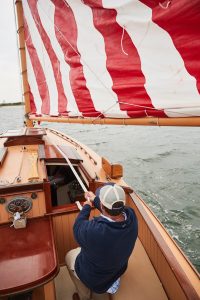So, Why A Catboat?
There are many different types of sailboats and they are defined by three distinct characteristics: hull type, keel type, and mast/sail configuration.
The most traditional and common hull type on a sailboat is a monohull—a single hull. The other two, catamarans and trimarans, have great advantages in speed which makes them great for performance sailboats. Also, the distance between the hulls on a catamaran provides excellent stability. Unlike the catamaran, which relies on its breadth for stability, most monohulls must rely on ballast for their stability; all but the catboat. Even though catboats have a small amount of ballast to add stability, they mostly rely on their massive beams (widths) and heavy hulls to stay upright.
Next is the keel. The keel of a boat counters the force of the wind and creates forward motion with lift; however, a keel also provides ballast. There are several types of keel: full keel, fin keel, wing or bulb keel, bilge keel, and centerboard. They all have their pros and cons. The keel on a Catboat is a centerboard. A centerboard is a keel that can be raised and/or lowered by the crew as is needed. This significantly reduces draft, which enables the catboat to sail in places where other sailboats cannot go.
Last distinction, and possibly the most obvious, is mast and sail configuration. There are several mast and sail configurations: Sloop, Fractional Rig Sloop, Cutter, Ketch, Schooner, Yawl, and Cat. The most obvious distinction of a Catboat sail configuration is a single sail and well-forward mast. Like the Catboat, some of the other configurations have a single mast; however, all of them have multiple sails. So, why a Catboat? Well, we’ll tell you…
Like our Captain, Catboat Charters takes great pride in our roots. The Catboat’s history in New England is a long and important one. Catboats were working boats, passenger ferries, and fishing boats. In fact, the name ‘Catboat’ comes from the fishermen having to shoo all of the cats from the boat who were after the dead fish! Catboats were particularly convenient in New England because of their seaworthy hull shape, shallow draft, and retractable centerboard. Fishermen were able to get into much shallower waters and also fish offshore on occasion.
Around the turn of the century, Catboats saw their workdays come to an end. People were now turning to them for vacation, not vocation. The Catboat became a racing boat of choice in New England and a day sailing passenger boat. Their wide structure made them roomy and comfortable for families and friends. That’s where we come in…
Captain Kurt inherited his love of Catboats from his father (if Kurt Peterson is the Captain, does that make his father Admiral Peterson? We think it might). Kurt’s family had many sailing adventures on their Catboats. So, when Kurt was looking for a vessel to fulfill his dreams of sharing his love of sailing with other families, there was no question what he would choose. Tigress and Captain Kurt are the perfect team.
Thanks so much for reading! Happy sailing.
